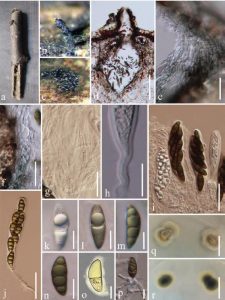Helicascus chiangraiensis Z.L. Luo, J.K Liu, H.Y. Su & K.D. Hyde, sp. nov., Index Fungorum number: IF 552003
Etymology: With reference to the location of this taxon.
Saprobic on decaying, submerged wood in freshwater. Sexual morph: Ascostromata 240–270 μm diam, 340–550 μm high, solitary, scattered, black, immersed, unilocular, globose to subglobose, ostiole central. Peridium 30–50 μm, subhyaline to dark brown, composed of several layers of pseudoparenchymatous cells, outer layer dark brown, with thick-walled cells, arranged in a textura angularis, inner layer hyaline with flattened, thin-walled cells. Hamathecium composed of septate, hypha-like pseudoparaphyses, 1.5–2.5 μm wide, slightly constricted at the septa, ramified above asci with free ends, embedded in a gel matrix. Asci 77–146 × 16–19 μm (x̅ = 111.5 × 17.5 μm, n = 20), 8-spored, bitunicate, fissitunicate, clavate, apically rounded, dehiscence, endoascus narrow, coiled within ectoascus, ectoascus forming a long tail extension. Ascospores 24.5–27.5 × 8.5–10.5 μm (x̅ = 26 × 9.5 μm, n = 20), obliquely uniseriate and partially overlapping, ellipsoid-fusiform, verruculose, upper end narrowly rounded, lower end tapering, slightly curved in side view, with 2–4 large refractive guttules, 1-euseptate, septum submedian, hyaline when young, becoming brown when mature, thick-walled, verruculose, slightly constricted at the septum, surrounded by sheath. Asexual morph: Undetermined.
Material examined: THAILAND. Chiang rai Province, saprobic on decaying wood submerged in a pond, October 2013, Asanka Bandara, ZL-11 (MFLU 15–0084, holotype); ex-type living culture, MFLUCC 13-0883, DLUCC; (HKAS 86459, isotype).
Notes: Helicascus chiangraiensis was collected from decaying wood submerged in a pond in Chiang rai Province, Thailand. According to the key provided by Zhang et al. (2013), H. chiangraiensis is similar to H. aegyptiacus by its coiled endoascus, verruculose ascospores surrounded by a gelatinous sheath and both are collected from freshwater habitats. However, H. chiangraiensis differs from H. aegyptiacus in having unilocular, smaller ascostromata, while H. aegyptiacus has a longer ascostromata, pseudostromata with 2–3(4) dark locules (Table 2). In addition, the molecular analysis also showed that these two species are phylogenetically distinct from each other.
Fig. 2. Helicascus chiangraiensis (MFLU 15–0084, holotype) a Specimen; b Appearance of black cirrhus of ascospores on surface of host; c Section of ascoma; d Longitudinal section of ascoma; e, f Section of peridium; g Paraphyses. h–j Asci; k–o Ascospores; p Germinating ascospore; q–r Culture grow on PDA after 3 weeks, q upper side, r reverse side. Scale bars: d = 150 μm; e–g = 25 μm; h–j = 30 μm; k–p = 10 μm; q, r = 10 mm.

